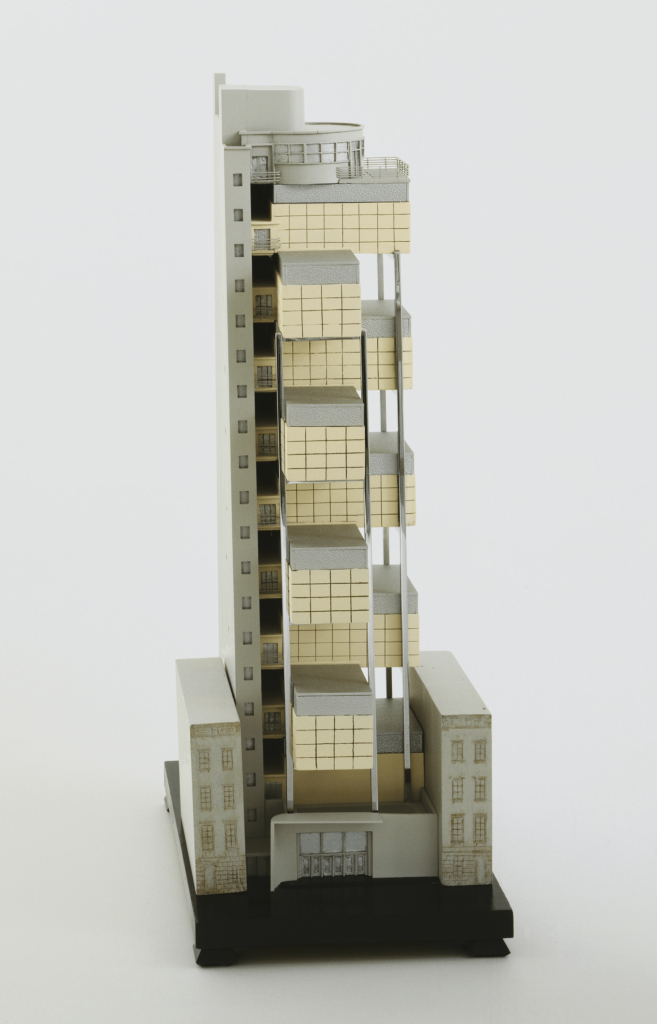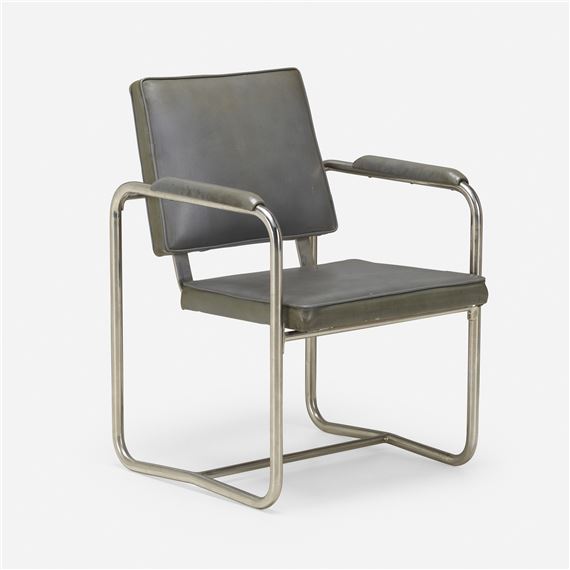
The Museum of Modern Art, New York (Scheme 4, First Variation)
1930 MoMA
William Lescaze (1896 – 1969), the pioneering Swiss architect and designer, left an indelible mark on architecture and design. His visionary approach and innovative creations revolutionized the field, inspiring generations of architects and artists. This blog post delves into Lescaze’s diverse career, from his architectural achievements to his forays into furniture design and painting. We also explore his participation in exhibitions and the recognition he received for his contributions to the arts.

Early Career and Architectural Ventures
After completing his education in Switzerland, Lescaze began his career in France. In 1919-1920, he worked on projects for the Committee for the Reconstruction of Devastated France and gained valuable experience in the architecture office of Henri Sauvage in Paris. 1920, he embarked on a new chapter, immigrating to the United States. He worked as a draughtsman for architects Hubbell and Benes in Cleveland, Ohio, before joining Walter R. MacCornack at the Bureau of Design of the Cleveland Board of Education. During this time, Lescaze designed a warehouse in 1922 and honed his architectural skills.
Architectural Collaborations and Notable Projects
Lescaze’s career blossomed when he established his practice in New York City in 1923. In subsequent years, he collaborated with esteemed architects such as George Howe, leaving an indelible mark on the architectural landscape. One of their most outstanding achievements was the Philadelphia Savings Fund Society (PSFS) building, a groundbreaking example of the International Style. Completed between 1929 and 1932, the PSFS building is a testament to Lescaze’s design prowess and innovation.
Throughout his career, Lescaze undertook various architectural projects that showcased his versatility and design acumen. Noteworthy examples include the Edgewood School in Greenwich, Connecticut, which combines collegiate Gothic style with modernist influences, and the progressive schools in Philadelphia and New York, which collaborated with George Howe. Additionally, Lescaze designed the Frederick Vanderbilt House in New Hartford, Connecticut, one of the earliest International Style residences in the United States.

Furniture and Product Design
William Lescaze’s creative talents extended beyond architecture. He ventured into furniture and product design, crafting pieces that embodied the modernist aesthetic. His designs showcased clean lines, functionality, and seamless integration with his architectural projects. Unique furniture designs include metal cantilever chairs and upholstered seating for the PSFS and the CBS building in Los Angeles. Lescaze also designed furniture and lighting for various spaces, including his residence at 211 East 48th Street in New York and Andrew Geller shoe stores in 1928.

Salt and Pepper Shakers
c. 1935 The Met
Artistic Expressions and Exhibitions
In addition to his architectural and design contributions, Lescaze’s artistic expressions included painting. He embraced abstract and geometric forms, reflecting the modernist movement’s influence. His paintings showcased his mastery of composition and balance, and their abstract nature often mirrored the principles he applied in his architectural designs.

Lescaze’s work was recognized and exhibited in prestigious venues. His furniture, fabrics, and accessories were featured in the 1927 ‘Art in Industry’ exhibition at the Halle Brothers department store in Cleveland. He also designed room settings for the 1928 Exposition of Art in Industry at Macy’s’ in New York. Lescaze’s contributions were included in exhibitions at the Metropolitan Museum of Art, such as the 1934 ‘Contemporary American Industrial Art’ and the 1940 ‘Contemporary American Industrial Art’ exhibitions.
William Lescaze’s journey through architecture, design, and artistic expression highlights his multifaceted talent and enduring legacy. His architectural achievements, collaborations, and innovative designs left an indelible mark on the modernist movement. Furthermore, his forays into furniture design, painting, and exhibition participation showcased his versatility and creative vision. Lescaze’s contributions inspire architects, designers, and artists, reminding us of the power of innovation and the boundless possibilities of artistic expression.
Sources
Byars, M., & Riley, T. (2004). The design encyclopedia. Laurence King Publishing. https://amzn.to/3ElmSlL
Caramellino, G. (2016). Europe Meets America: William Lescaze, Architect of Modern Housing. United Kingdom: Cambridge Scholars Publishing. https://amzn.to/4bOK7EN
Design History: An Anthology. (1995). United Kingdom: Penguin Random House LLC. https://amzn.to/3wWbJZR
More on Swiss Design
More design articles
Discover more from Encyclopedia of Design
Subscribe to get the latest posts sent to your email.





